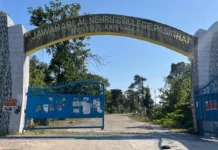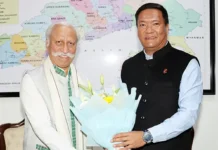[ Noklem Wangjen ]
The Kra Daadi District Administration, in collaboration with Kamjaaring Home Stay Tour Operator is organising “Col Betts Trekking Trail”, a trekking event, from December 7 to 9 next.
The mission behind organising “The Col Betts Trekking Trail” is to re-discover and re-experience the historical trekking route followed by the Britishers to survey and explore nodal administrative headquarters for effective administration of the North East Frontier Agency (NEFA).
In 1946, Col Betts, who was the Political Officer of the then Subansiri Frontier Tract, established his headquarters at Kore above Talo village. Prior to him, Professor Christopher Von Haimendorf, the British anthropologist had explored the area and even visited Mengio, Guchi and Mengi Kabak and reached Nilling village in Upper Subansiri following the Selu River, a tributary of Kumey River.
Col Betts started exploring the area to extend the British Administration over the area and trekked along the present day Ziro-II area. He crossed Bigek River and reached Amji-Bokam in Palin area and met Khyoda Talam. He was accompanied by his wife Ursula Graham Bower, who later penned her memoirs in the book titled, ‘The Hidden Land’.
The team toured the entire area, camping at various locations in Rakso, Lumba, Tassar, etc. He met with senior personalities, like Dolang Eo and Biri Hassang. Thus, Palin valley was the first area in the Upper Nyishi belt to have the impact of British administration. The team returned to Kore via Yapap Bogu-Saya-Nyelam.
This trekking program is an attempt to retrace our history and make the trail an important tourism trail, covering the Apatani plateau and Palin valley.
This historical trail can be incorporated into our Tourism Department’s website and “The Col Betts Trekking Trail” can be promoted as a major annual state tourism event, where foreign or local tourists can participate and understand our rich cultural heritage as well as our pristine and rich natural biodiversity.
This in turn can give a fillip to local employment generation in the form of cultural and adventure tourism through promotion of village home stays and employment opportunities to the educated unemployed local youths as guides and tour operators, etc.
The rejuvenation of this trekking route would also strengthen the age old cultural and economic ties between the Nyishis and Apatanis and also cement mutual harmony and peaceful co-existence.
The three-day trekking program would begin from Old Ziro in Lower Subansiri and culminate at Amjiring Palin in Kra-Daadi District with a night-halt camp along the bank of Bigek River -a historic and traditional boundary between the Nyishi and Apatani tribes.
The Col Betts Trekking Trail would also offer a golden opportunity for exploration and new discoveries for anthropologists, naturalists, ornithologists, adventurist, lepidopterologists, ichthyologists, entomologist, botanists, zoologists, geologists. (The contributor is an APCS officer posted in Kra-Daadi district)





